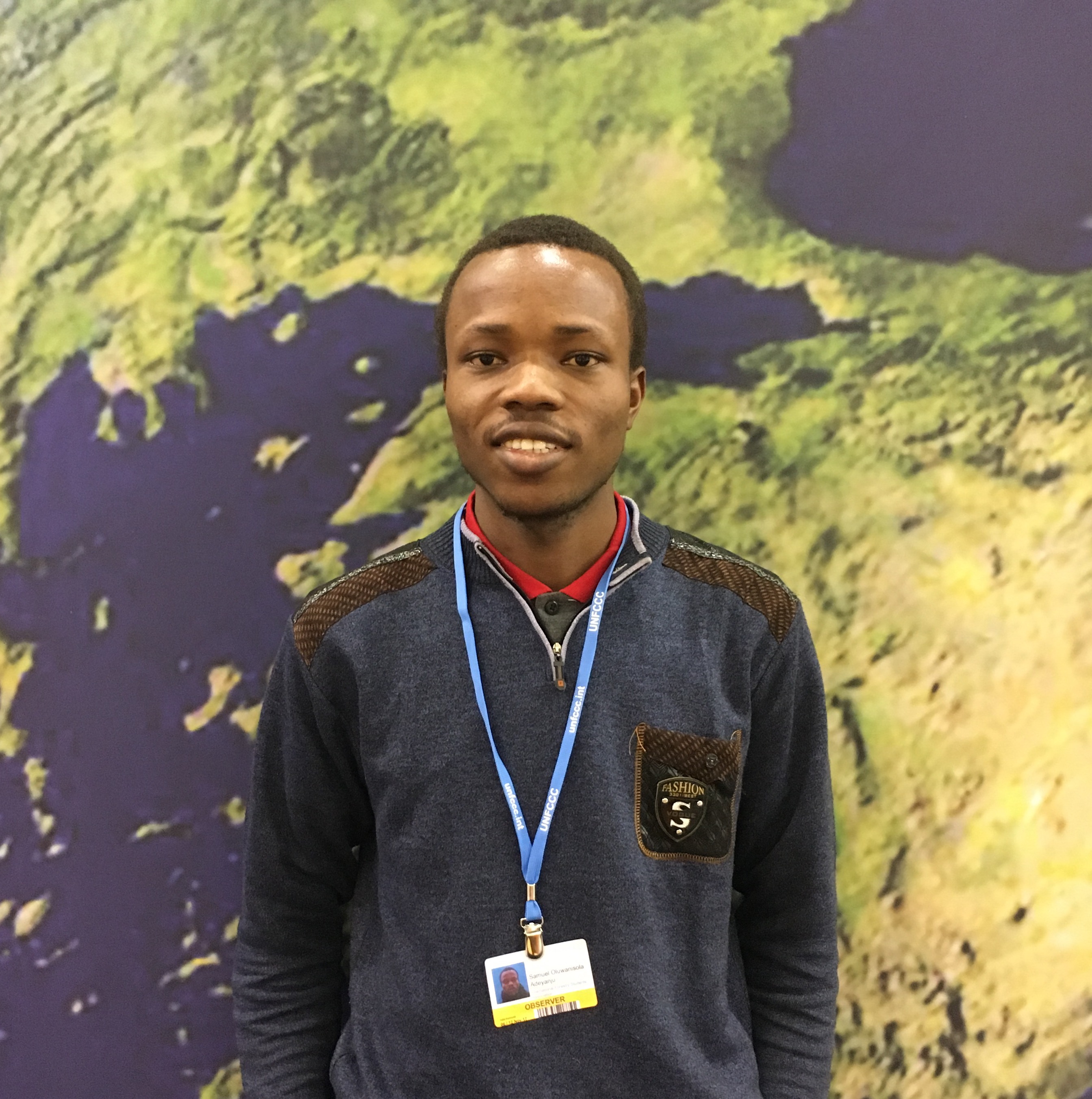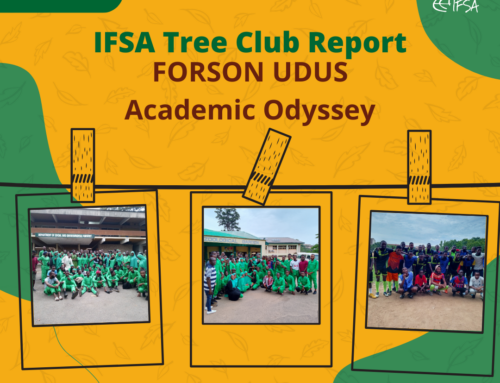Al Gore, former vice president of the USA, is a big name in the climate change world, and founded the Climate Reality Project, a non-profit organisation devoted to solving the climate crisis. His status as a ‘climate celebrity’ was confirmed by the huge number of attendees at the event, including journalists, young people, and climate change enthusiasts, who were seated in the room for over an hour before the event was scheduled to commenced.
There was a lot of energy and expectations in the room as participants waited for the arrival of Mr. Gore. His entrance was announced by camera flashes from every angle of the room as he approached the podium. I wasn’t left out, as I have suddenly joined the league of photo journalists at COP… Haha.
His speech provided a deep insight into various climate disasters across the globe, both in the global south and north. He ended his presentation by highlighting the potential of wind and solar energy, and spoke of the numerous efforts being made by countries like India to implement the Paris Agreement by transitioning to clean and renewable energy. Below is a summary of the talk – I hope you enjoy it.
 Devastating hurricanes have become the new normal in many coastal areas of the world. Storms such as hurricane Harvey, Irma and Maria caused up to US $350 billion in damage this year. Puerto Rico received 91cm of rain in just 24 hours, leaving 83% of people without access to electricity. Just 2 weeks ago, Argentina was hit with 1.5 metres of hail in 15 minutes. The Caribbean and Virgin Islands are also vulnerable to severe weather events. Storms of a ferocity that formerly occurred once every 500 years now occur every 25 years. By 2030 to 2045, such storms are predicted to occur every 5 years. We have to change!
Mr. Gore also spoke of South Africa’s Western Cape, which was declared 2 weeks ago to be in drought, and he stressed that more attention should be paid to Africa. As of November 2017, eight African and Middle Eastern countries are approaching famine and 30 million people are nearing starvation. It is the first time in recent memory that so many large-scale hunger crises have occurred simultaneously. This month, the United Nations issued warnings that the world is facing the worst humanitarian crisis since 1945.
Devastating hurricanes have become the new normal in many coastal areas of the world. Storms such as hurricane Harvey, Irma and Maria caused up to US $350 billion in damage this year. Puerto Rico received 91cm of rain in just 24 hours, leaving 83% of people without access to electricity. Just 2 weeks ago, Argentina was hit with 1.5 metres of hail in 15 minutes. The Caribbean and Virgin Islands are also vulnerable to severe weather events. Storms of a ferocity that formerly occurred once every 500 years now occur every 25 years. By 2030 to 2045, such storms are predicted to occur every 5 years. We have to change!
Mr. Gore also spoke of South Africa’s Western Cape, which was declared 2 weeks ago to be in drought, and he stressed that more attention should be paid to Africa. As of November 2017, eight African and Middle Eastern countries are approaching famine and 30 million people are nearing starvation. It is the first time in recent memory that so many large-scale hunger crises have occurred simultaneously. This month, the United Nations issued warnings that the world is facing the worst humanitarian crisis since 1945.
 There has been a recent increase in temperatures and in wildfire frequency and intensity across the global. Early this year, 400 thousand hectares were burnt in Chile. Similar events have occurred in countries such as the US, Canada and Australia. In 2010, 55,000 people were killed in the worst fire and drought event ever in Russia’s history, Four months after the fire, Russia took all of its grain off the world market, and food prices reached a record high for the second time in 3 years, causing food riots in 16 countries in South Asia and South America.
Not only are humans migrating away from unliveable areas, but land-based animal and plant species are also moving at an average of 4.5 metres per day. We are in danger of loosing up to half of all terrestrial species by the end of this century. The relationship between humans and microbes has always been mediated by climate, and we are tilting the balance in favour of microbes and vectors that carry diseases. This problem has been compounded by air travel, which helps to spread tropical diseases to high latitudes. Indian cities have the highest level of air pollutions in the world, surpassing even China, and over 4000 schools were closed due to air pollution in the past week. Japan and China are the biggest funders of dirty coal plants in places like Indonesia, Vietnam and other developing countries. Above average temperatures have caused glacier to melt in Greenland and Antarctica, leading to high tides and sea level rise. It is clear that we have to change because we are in the process of destroying human civilisation.
There has been a recent increase in temperatures and in wildfire frequency and intensity across the global. Early this year, 400 thousand hectares were burnt in Chile. Similar events have occurred in countries such as the US, Canada and Australia. In 2010, 55,000 people were killed in the worst fire and drought event ever in Russia’s history, Four months after the fire, Russia took all of its grain off the world market, and food prices reached a record high for the second time in 3 years, causing food riots in 16 countries in South Asia and South America.
Not only are humans migrating away from unliveable areas, but land-based animal and plant species are also moving at an average of 4.5 metres per day. We are in danger of loosing up to half of all terrestrial species by the end of this century. The relationship between humans and microbes has always been mediated by climate, and we are tilting the balance in favour of microbes and vectors that carry diseases. This problem has been compounded by air travel, which helps to spread tropical diseases to high latitudes. Indian cities have the highest level of air pollutions in the world, surpassing even China, and over 4000 schools were closed due to air pollution in the past week. Japan and China are the biggest funders of dirty coal plants in places like Indonesia, Vietnam and other developing countries. Above average temperatures have caused glacier to melt in Greenland and Antarctica, leading to high tides and sea level rise. It is clear that we have to change because we are in the process of destroying human civilisation.
 The World Economic Forum has stated that the climate crisis is the number one threat to the global economy. The good news, however, is that we have the solution at hand. 17 years ago it was (optimistically) predicted that the world would be able to generate 30 gigawatts of wind power by 2010. However, we have so far exceeded that 16 times over, and wind energy is now the cheapest form of electricity. 15 years ago projections forecasted that we could obtain 1 gigawatt of power from solar energy – we generated 75 times this amount last year. Denmark is one of the leaders in wind energy, and, during one 24-hour period last year, 100 percent of their energy needs came from this source. The US has enough wind energy to power more than 25 million homes. On a global scale, wind can supply 40 times as much energy as the entire global economy consumes.
The World Economic Forum has stated that the climate crisis is the number one threat to the global economy. The good news, however, is that we have the solution at hand. 17 years ago it was (optimistically) predicted that the world would be able to generate 30 gigawatts of wind power by 2010. However, we have so far exceeded that 16 times over, and wind energy is now the cheapest form of electricity. 15 years ago projections forecasted that we could obtain 1 gigawatt of power from solar energy – we generated 75 times this amount last year. Denmark is one of the leaders in wind energy, and, during one 24-hour period last year, 100 percent of their energy needs came from this source. The US has enough wind energy to power more than 25 million homes. On a global scale, wind can supply 40 times as much energy as the entire global economy consumes.
 Norway, the Netherlands, India, Scotland, France and Britain are all planning a fossil fuel vehicle phase out between 2025 and 2040. In the U.S, 100 leading multinational companies have pledged to support the Paris Agreement, regardless of whether or not the US exit.
In all, the consequences of climate change across the globe indicate that we have to change NOW!!!
Norway, the Netherlands, India, Scotland, France and Britain are all planning a fossil fuel vehicle phase out between 2025 and 2040. In the U.S, 100 leading multinational companies have pledged to support the Paris Agreement, regardless of whether or not the US exit.
In all, the consequences of climate change across the globe indicate that we have to change NOW!!!
 Samuel Adeyanju is from Nigeria, and is an MSc student in the faculty of Forestry at the University of British Columbia (UBC), Canada. His research interests revolve around community forestry, forest certification systems, forest policy and governance.]]>
Samuel Adeyanju is from Nigeria, and is an MSc student in the faculty of Forestry at the University of British Columbia (UBC), Canada. His research interests revolve around community forestry, forest certification systems, forest policy and governance.]]>




